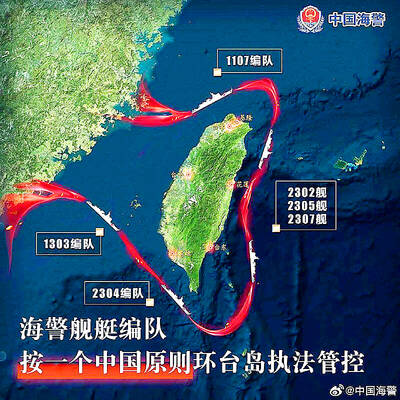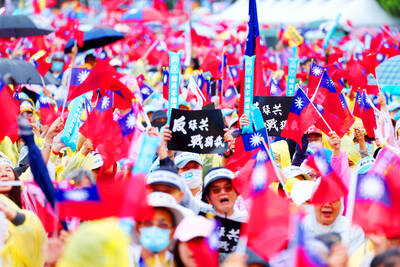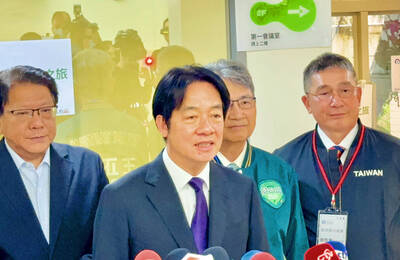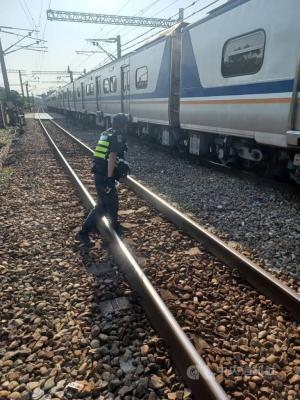While some people might find the sight of oily food detestable, for Maruyama Junko, oil collected from the campus cafeteria was a crucial ingredient in her artworks.
“Every week, I collect about 70 liters of oil from food served in the school cafeteria and mix it with water,” said Maruyama, a Japanese artist in residence at Kuandu Museum of Fine Arts, located on the campus of Taipei National University of the Arts.
“To me, that's where energy comes from — the mixture of oil and water,” she said. “And when I read something like the big bang theory, I try to recreate the vision using oil and water.”
With the aid of these two ingredients, Maruyama turned an ordinary restroom in the museum into an art exhibition.
Using the oil she had collected, she made a soap mixture and plastered it on the pedestal supporting the toilet bowl, turning it into brown, tree-like stump. She also used the same mixture to shape tree branches hanging over the toilet bowl. On the floor is a shallow pool where a mixture of oil and water creates mystifying patterns on the ground.
Aside from installation art, Maruyama has also opened a flower shop on campus. A closer look at these floral creations reveals flowers made from different plastic bags — ranging from the ordinary red-striped ones to those from 7-Eleven convenience stores or Watson's.
The artist-in-residency program sponsored by the museum allows Maruyama and artists from other countries to engage in creative projects without any distraction.
In Japan, Maruyama said she had to take several part-time jobs simultaneously to continue her artistic pursuits.
“In Japan, life was so stressful. I got sort of crazy because of that stressful lifestyle,” she said. “Here life is calm. I can go for a walk in the woods and feel completely refreshed.”
To Seth Lower from the US, the residency program gave him an opportunity to live in a non-English speaking country for the first time.
Lower was here for a project called “Looking for Lee Ming” (尋找李明), who sent him an e-mail from Taiwan last year and told him that he knew him from a dream he had many times in his life. Lee said Lower was the angel in the dream that fought the people who tried to hurt him and sacrificed his life eventually.
“And he [the angel] wrote with his blood on my hand as he died in my arms. Then I remembered, the name that guy wrote. It was your name,” Lee said in his e-mail to Lower.
“Immediate shock” was his initial response, Lower said. “But pretty quickly the feeling went from being scared to wondering what might have happened if this was true.”
He later pitched the idea of finding Lee Ming in Taiwan when he applied for the museum's residency program and got accepted.
Lower said that his past works dealt with coincidences, and he was interested in seeing how the multiplicity of coincidences generates different possibilities.
Lower soon acquired the help of two Taiwanese students, who were assigned by the program to work on the project with him. They posted the message on the university's bulletin board system and waited for a response. They took Lower to Longshan Temple in Taipei and sought guidance from fortune tellers. Lower also met several people called Lee Ming on Facebook in Taipei.
On a trip to Jiufen (九份), the team asked a passersby to pose as Lee Ming in the dream, while Lower, as the angel, pretended to die in Lee's arms.
Lee then turned the quest for a mystic figure into a documentary, which was interwoven with images like traditional puppet shows and the festival rituals at Longshan Temple.
Lower never found Lee Ming. But the search led him to explore a bit more about the country that produced directors like Hou Hsiao-hsien (侯孝賢) and Ang Lee (李安).
“It is interesting to see how the art community could happen in such a traditional place,” he said. “And see how the works get balanced — thinking about moving forward, thinking about the past, and thinking about how to differentiate these two aspects.”
Like most foreigners, Lower said he also experienced some cultural shock.
“I met a guy on a motorcycle who screamed waiguoren [foreigner] at me,” he said. “It was a bit unnerving to be constantly reminded that you are an outsider.”
But he felt pretty much at home overall, and the life he had here was no different from what he had in San Francisco.
Ho Ming-kuei (何明桂), the program coordinator, said the artist-in-residence program started two years ago, when the museum officially appropriated budget to subsidize the artists.
“At the beginning, not too many artists knew about the program so that we had very few applications,” she said, adding that the information later spread through word-of-month and now they have about 20 applicants per year.
Artists who want to participate in the program must first pitch their ideas, which are reviewed by a committee of specialists who select two to three artists. Each artist can stay between two weeks and two months, depending on the time needed to finish their project.
Besides working on the projects, the museum arranges for the resident artists to teach university students in workshops, talk to visitors in a question-and-answer session and explore the art community in Taiwan, Ho said.
Ho said the subsidy only pays for boarding at the university's dormitory and the expenses needed to complete the projects. Artists must pay for their flights to Taiwan and their own living expenses.
“The money may not be much, but our staff try their best to help the artists put their creativity to life,” she said.
Since 2007, the program has subsidized five artists, mainly from Japan and the US. For details, visit http://kdmofa.tnua.edu.tw.

Taiwan would benefit from more integrated military strategies and deployments if the US and its allies treat the East China Sea, the Taiwan Strait and the South China Sea as a “single theater of operations,” a Taiwanese military expert said yesterday. Shen Ming-shih (沈明室), a researcher at the Institute for National Defense and Security Research, said he made the assessment after two Japanese military experts warned of emerging threats from China based on a drill conducted this month by the Chinese People’s Liberation Army’s (PLA) Eastern Theater Command. Japan Institute for National Fundamentals researcher Maki Nakagawa said the drill differed from the

‘WORSE THAN COMMUNISTS’: President William Lai has cracked down on his political enemies and has attempted to exterminate all opposition forces, the chairman said The legislature would motion for a presidential recall after May 20, Chinese Nationalist Party (KMT) Chairman Eric Chu (朱立倫) said yesterday at a protest themed “against green communists and dictatorship” in Taipei. Taiwan is supposed to be a peaceful homeland where people are united, but President William Lai (賴清德) has been polarizing and tearing apart society since his inauguration, Chu said. Lai must show his commitment to his job, otherwise a referendum could be initiated to recall him, he said. Democracy means the rule of the people, not the rule of the Democratic Progressive Party (DPP), but Lai has failed to fulfill his

A rally held by opposition parties yesterday demonstrates that Taiwan is a democratic country, President William Lai (賴清德) said yesterday, adding that if opposition parties really want to fight dictatorship, they should fight it on Tiananmen Square in Beijing. The Chinese Nationalist Party (KMT) held a protest with the theme “against green communists and dictatorship,” and was joined by the Taiwan People’s Party. Lai said the opposition parties are against what they called the “green communists,” but do not fight against the “Chinese communists,” adding that if they really want to fight dictatorship, they should go to the right place and face

A 79-year-old woman died today after being struck by a train at a level crossing in Taoyuan, police said. The woman, identified by her surname Wang (王), crossed the tracks even though the barriers were down in Jhongli District’s (中壢) Neili (內壢) area, the Taoyuan Branch of the Railway Police Bureau said. Surveillance footage showed that the railway barriers were lowered when Wang entered the crossing, but why she ventured onto the track remains under investigation, the police said. Police said they received a report of an incident at 6:41am involving local train No. 2133 that was heading from Keelung to Chiayi City. Investigators